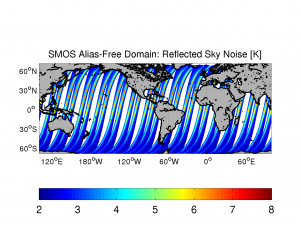Galactic radiation glints over the ocean seen by SMOS
by Joseph Tenerelli from CLS/Brest
As illustrated in the figures below, recent SSS retrievals produced by DPGS show along-track strips of low SSS in descending orbits that are aligned with the expected maximum in galactic noise contribution to the brightness temperatures:
Image of a SMOS Level 2 SSS retrieval for one 1/2 orbit in Descending passes the 25th of september. Note the blue (too fresh) along-track strips due to bad correction of the galactic signal reflection on the sea surface.
Model prediction of the specularly reflected galactic equator radiations for that period (Kelvins).
The most convincing evidence that the galactic noise model is the origin of these low SSS streaks is obtained by collecting the SMOS data onto celestial dwelllines and subtracting from the SMOS brightness temperatures ((Tx+Ty)/2 all radiative transfer forward model contributions except the galactic noise.
What remains should be the reflected celestial sky noise, and indeed that is what we find. Below is a gif animated (click on it to see the animation) of the median of the differences between alias free FOV SMOS brightness temperatures and the radiative transfer forward model without sky noise, projected on to the celestial sphere (here we assumed SSS to be equal the world Ocean Atlas climatology). The first image in the animation is showing the model for the specularly reflected sky image as shall be seen by SMOS if the ocean surface were perfectly smooth, the following images in the animation are showing the SMOS data classified as function of the surface wind speed values by 3m/s wide bins (from low to higher winds).
Click on the image above to see the gif-animation
To make these maps we have used many Pacific ascending and descending passes from April through September, although the signal appears clearly even in single passes. As expected, the ocean surface reflected images of the L-band sky radiations seen by SMOS are blurred by the roughness of the sea surface. The stronger the surface winds, the weaker the scattered signal from the galactic equator and the more spread the associated signal.
Examination of the SMOS brightness temperatures and comparison with the scattering model reveals deficiencies in our modeling of the celestial sky noise that are at the origin of these strips of spuriously low SSS: in general the Kirchoff scattering model we used underestimates the scattered energy from the galactic equator, meaning that our sea surface scattering model is overpredicting the L-band roughness effect. An adapted correction is understudy.
Clearly, the combined stability of the galactic sources and the SMOS imaging capacity of these sky sources form a very promising tool for correctly adjusting our rough-sea surface scattering model at L-band. More details can be found in the Cersat salinity Center web site.



